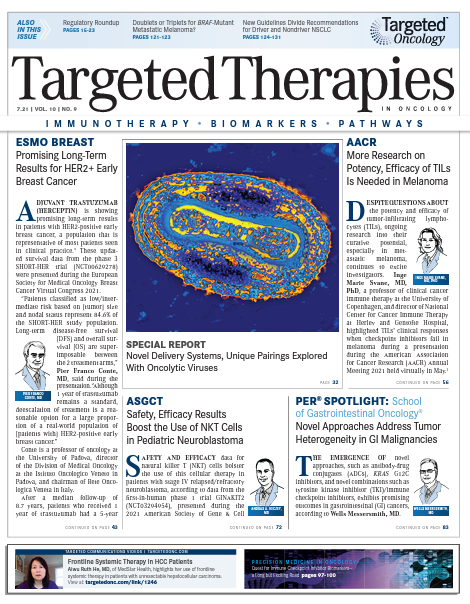Molecular Profiling Is the Future of Biliary Tract Treatment
Although the genetic makeup of biliary tract cancer is rich, only recently has the field been able to show the benefit of treating patients with effective targeted agents, in the advanced setting.

The most exciting development in cholangiocarcinoma is molecular profiling, according to Flavio G. Rocha, MD, FACS, FSSO, during a presentation during the 6th Annual School of Gastrointestinal Oncology® hosted by the Physicians Education Resource®, LLC (PER®). Although the genetic makeup of biliary tract cancer is rich, only recently has the field been able to show the benefit of treating patients with effective targeted agents, such as pemigatinib (Pemazyre) and ivosidenib (Tibsovo) in the advanced setting, Rocha said, adding that the momentum is expected to continue in the preoperative setting. Rocha serves as Hedinger Chair, division head and professor of surgery in the Division of Surgical Oncology at Oregon Health & Science University in Portland.
One of the first demonstrations of the potential application of molecular profiling came from the phase 2 FIGHT-202 trial (NCT02924376) which stratified patients with pretreated locally advanced or metastatic cholangiocarcinoma with known FGFR status into 1 of 3 cohorts.¹ Cohort A (planned, n = 100) consisted of patients with FGFR2 fusions or rearrangements, cohort B (planned, n = 20) consisted of patients with other FGF/FGFR alterations, and cohort C (planned, n = 20) consisted of patients with no FGF/FGFR alterations. All patients received 13.5 mg of pemigatinib, a selective oral inhibitor of FGFR1/2/3, once daily for a schedule of 2 weeks on and 1 week off.
The primary end point, which was confirmed objective response rate (ORR) in cohort A by independent central review, was 35.5%, and the median duration of response was 7.5 months. The 35.5% ORR consisted of 3 (2.8%) complete responses, 35 (32.7%) partial responses, and 50 (46.7%) patients with stable disease, for a disease control rate of 82%.
At a median follow-up of 15.4 months and a median duration of treatment of 7.2 months, the median overall survival (OS) was 21.1 months in patients with FGFR2 fusions/ rearrangements (95% CI, 14.8-not evaluable; cohort A). The median OS was only 6.7 months in patients with other FGF/FGFR alterations (95% CI, 2.1-10.6; cohort B) after a median follow-up of 19.9 months, and it was only 4.0 months in patients without an FGF/FGFR alteration after a median follow-up of 24.2 months (95% CI, 2.3-6.5; cohort C).
“By far, the cohort that had the [FGFR2] fusions and translocations really had the most benefit,” Rocha said. “In the second-line setting, we saw a median OS of 21 months [in that population], which far exceeds the current standard from the ABC-06 trial, which is [folinic acid, fluorouracil, and oxaliplatin] FOLFOX.” In April 2020, the FDA approved pemigatinib for the treatment of patients with previously treated, locally advanced, or metastatic cholangiocarcinoma with FGFR2 fusions or rearrangements, as detected by an FDA-approved test, based on primary findings from the FIGHT-202 trial.²
Additional FGFR inhibitors under investigation in cholangiocarcinoma include infigratinib, (Truseltiq) which currently has priority review status with the FDA in this setting, as well as futibatinib, derazantinib, and erdafitinib (Balversa), all of which have shown ORRs ranging from approximately 20.7% to 57% in patients with FGFR2 fusion-positive cholangiocarcinoma.³
“Because we don’t want to wait for the results [in the advanced setting], [we’re] teaming up with the cholangiocarcinoma foundation [and] working on the concept [of neoadjuvant therapy] in the OPT-IC trial,” Rocha said.
In the OPT-IC trial (NCT03579771), patients with resectable intrahepatic cholangiocarcinoma will undergo molecular profiling with circulating tumor DNA, followed by 1 cycle of gemcitabine, nab-paclitaxel (Abraxane), and cisplatin (GAP) chemotherapy. Patients with an FGFR2 fusion (planned, n = 10) will go on to receive an FGFR2 inhibitor for 2 cycles, followed by surgery and adjuvant therapy; patients without an FGFR2 fusion (planned, n = 30) will receive another 2 cycles of GAP chemotherapy, followed by surgery and adjuvant therapy. Feasibility will serve as the primary outcome of the study, followed by response and recurrence-free survival.
IDH mutations are another common alteration seen across the spectrum of extrahepatic and intrahepatic cholangiocarcinoma and gallbladder carcinoma, Rocha said.
Findings from the phase 3 ClarIDHy trial put ivosidenib on the map for patients with IDH1 mutations. In the trial, patients with pretreated IDH1-mutant cholangiocarcinoma were randomized 2:1 to 500 mg of oral ivosidenib once daily in 28-day cycles (± 2 days; n = 124) or placebo (n = 61).4
Progression-free survival (PFS) served as the primary end point of the study. The median PFS was 2.7 months vs 1.4 months for ivosidenib and placebo, respectively (HR, 0.37; 95% CI, 0.25-0.54; P <.001). The 6-month PFS rate was 32% with ivosidenib vs not evaluable with placebo. The 12-month PFS rates were 22% and not evaluable, respectively. The disease control rates were 53% and 28%, respectively.
The IDH1 inhibitor also showed a nonstatistically significant improvement in OS. Although most patients crossed over to ivosidenib (57%), there was a 31% trend toward reduction in the risk of death with ivosidenib (HR, 0.69; 95% CI, 0.44-1.10; P = .06).
The median OS was 10.8 months with ivosidenib vs 9.7 months with placebo. At 6 months, 67% of patients in the ivosidenib arm remained alive compared with 59% in the placebo arm. Investigators performed an analysis looking at rank-preserving structural failure time (RPSFT) for placebo. With the RPSFT data, there was a 54% reduction in the risk of death with ivosidenib (HR, 0.46; 95% CI, 0.28-0.75; P <.001).
“When you actually looked at the adjusted data [accounting for the] patients [in the ivosidenib arm] who had [initially] received placebo, we saw an impressive difference of 10.8 months vs 6 months,” Rocha said.
On March 1, a supplemental new drug application was submitted to the FDA for ivosidenib tablets as a potential therapeutic option for patients with previously treated, IDH1-mutated cholangiocarcinoma, based on findings from the phase 3 ClarIDHy trial.
REFERENCES
1. Vogel A, Sahai V, Hollebecque A, et al. FIGHT-202: a phase 2 study of pemigatinib in patients (pts) with previously treated locally advanced or metastatic cholangiocarcinoma (CCA). Ann Oncol. 2019;30(suppl 5):V876. doi:10.1093/annonc/mdz394.031
2. FDA approves first targeted treatment for patients with cholangiocarcinoma, a cancer of bile ducts. News release. FDA. April 17, 2020. Accessed March 22, 2021. https://prn.to/2xGXrO6.
3. Rocha F. Emerging therapies and targets for cholangiocarcinoma. Presented at: 6th Annual School of Gastrointestinal Oncology®; March 20, 2021; virtual.
4. Abou-Alfa GK, Macarulla T, Javle MM, et al. Ivosidenib in IDH1-mutant, chemotherapy-refractory cholangiocarcinoma (ClarIDHy): a multicentre, randomised, double-blind, placebo-controlled, phase 3 study. Lancet Oncol. 2020;21(6):796-807. doi:10.1016/S1470-2045(20)30157-1
5. Agios submits supplemental new drug application to FDA for Tibsovo (ivosidenib tablets) for patients with previously treated IDH1-mutant cholangiocarcinoma. News release. Agios Pharmaceuticals Inc; March 1, 2021. Accessed March 22, 2021. http://bit.ly/301kg9R
